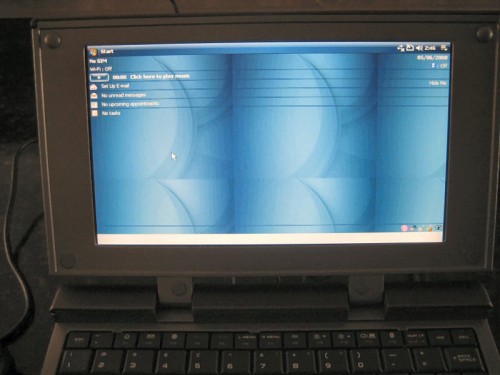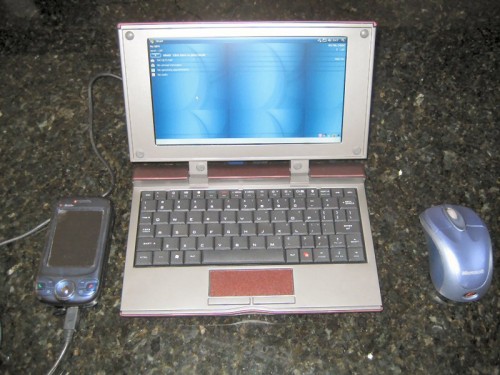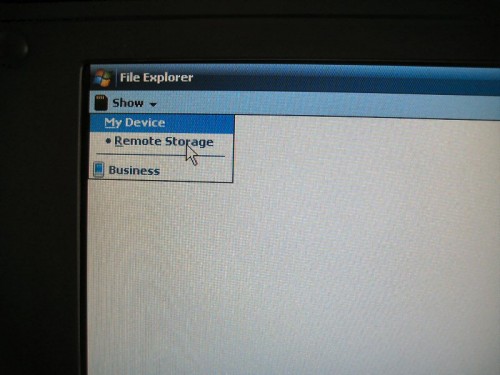In part one of my review of Celio’s REDFLY, I covered the REDFLY’s physical attributes. For part two I will cover the functionality of the device.
First, it is important to remember that the REDFLY will only work with Windows Mobile 5.0 or 6 Professional (PocketPC) and Standard (Smartphone) devices and currently only a small subset of the total number of devices available. For a complete list of what devices are supported visit . Having said that, I did test the REDFLY with a number of devices including several that were not on the Celio website. All of them worked just fine although older O2devices did tend to have a little graphics trouble. All of the HTC devices I tested – The AT&T Tilt, the T-Mobile Wing, and HTC Advantage – worked fantastically well. The same is true for current MWg devices – Atom Life and Zinc II – although I did not test it with the new Atom V. More devices are being added as Celio does more testing but if you use a device not listed on their site, they will not provide technical support for that device and the REDFLY.
As I indicated earlier, the REDFLY itself does not have any built-in memory or storage nor does it have an Operating System in itself. Rather, it utilizes those items on your Windows Mobile device. The best way to think of it is that the REDFLY is an extension of your device. It merely allows you to access data, applications and information on your device through a much more convenient and easy-to-use display and keyboard.
To begin using the REDFLY you must first load the REDFLY driver application onto your Windows Mobile device. This can be done via the included CD-ROM, from your desktop via ActiveSync or Windows Mobile Device Center or Over-The-Air by visiting the Celio website on your device. After soft-resetting, your device will automatically start the REDFLY application in the background. At this point you can connect your device to the REDFLY via a USB cable or Bluetooth and it will automatically connect and display your Windows Mobile’s Today screen on the REDFLY. It is literally that simple to connect!
On the back of the REDFLY are two USB 2.0 ports which will allow you to connect external devices such as a mouse or USB storage key. The REDFLY has a built int touchpad with both a left and righ key. I have never been a fan of touchpads myself so connecting an external mouse is a must for me. With the REDFLY it is simply a matter of plugging one into one of the USB ports. Windows Mobile has native mouse drivers (bet you didn’t know that!) so any USB mouse should work. I used a Microsoft Notebook mouse and it discovered it instantly. If you connect a USB key to the device, your Windows Mobile device will recognize it as a “Remote Storage” and will allow you to access files on the drive as well as store files to them.
One of the great features of the REDFLY keyboard is the F-Key row and shortcuts. Some of the shortcuts include the ability to open Internet Explorer or Messaging by pressing and holding the Windows Key and corresponding F-Key. It is another way of saving you some mouse clicks.
I have been using the REDFLY now for several weeks and have in fact taken it on two different business trips with me. I have to say it makes using my Windows Mobile device much easier, especially on airplanes. Given the small form factor of the REDFLY, I can easily open it up while in a seat in coach and still type and use the touchpad with no problem while having the bigger screen and keyboard to really “work” with my device. I also found that the REDFLY was quite durable, having no problems with the normal wear-and-tear of laptop bag travel.
The number one question I received here at Gear Diary after I posted part one of the REDFLY review circled around the $499.95 pricing. Most who wrote felt it was considerably too high and on the surface it indeed looks that way. Let’s however do a better comparison. In addition to the REDFLY I also have a HTC Advantage X7510. That device is approximately $1250 and includes a great 5″ VGA display, detachable keyboard and is a great device overall. If you were to purchase a T-Mobile Wing ($499) or AT&T Tilt ($599) and the REDFLY, you would still be anywhere from $999.90 to $1099.90 total, some $200-odd dollars less than the X7510. With this combination you would have a much larger 7″ display and full QWERTY keyboard, something you would not have on the X7510. So if you do a real comparision, the prices are actually in your favor by going with the REDFLY.
Ultimately there is little question the REDFLY is aimed at the business market and should do quiet well. Still, if you are a power Windows Mobile user, you should consider this handy device for your needs.
What I Like
Full Size Keyboard
USB Hub support for mice and USB keys
Instant On
What I Don’t Like
Not much – works fantastically well!
For more information visit the Celio Website


